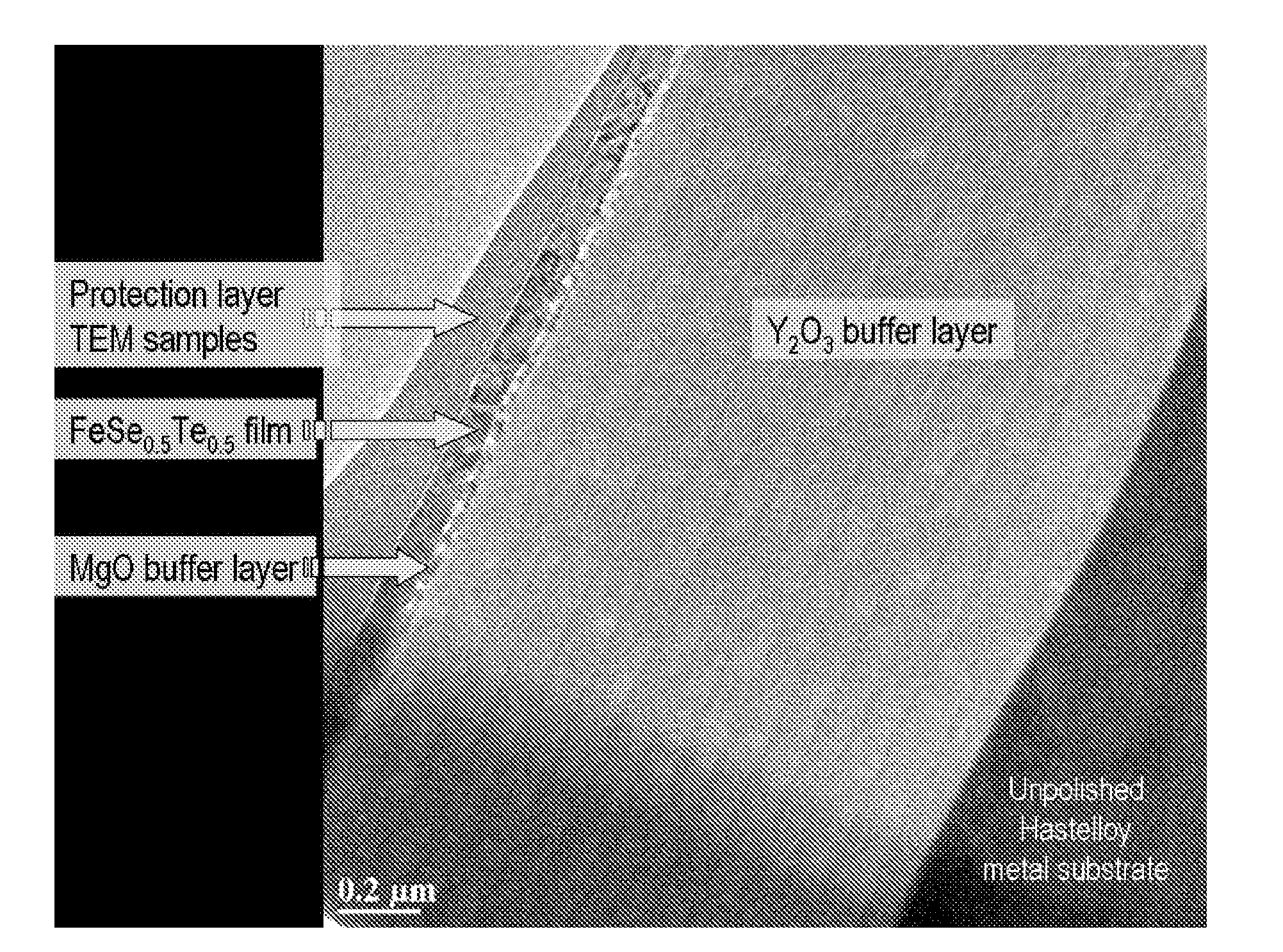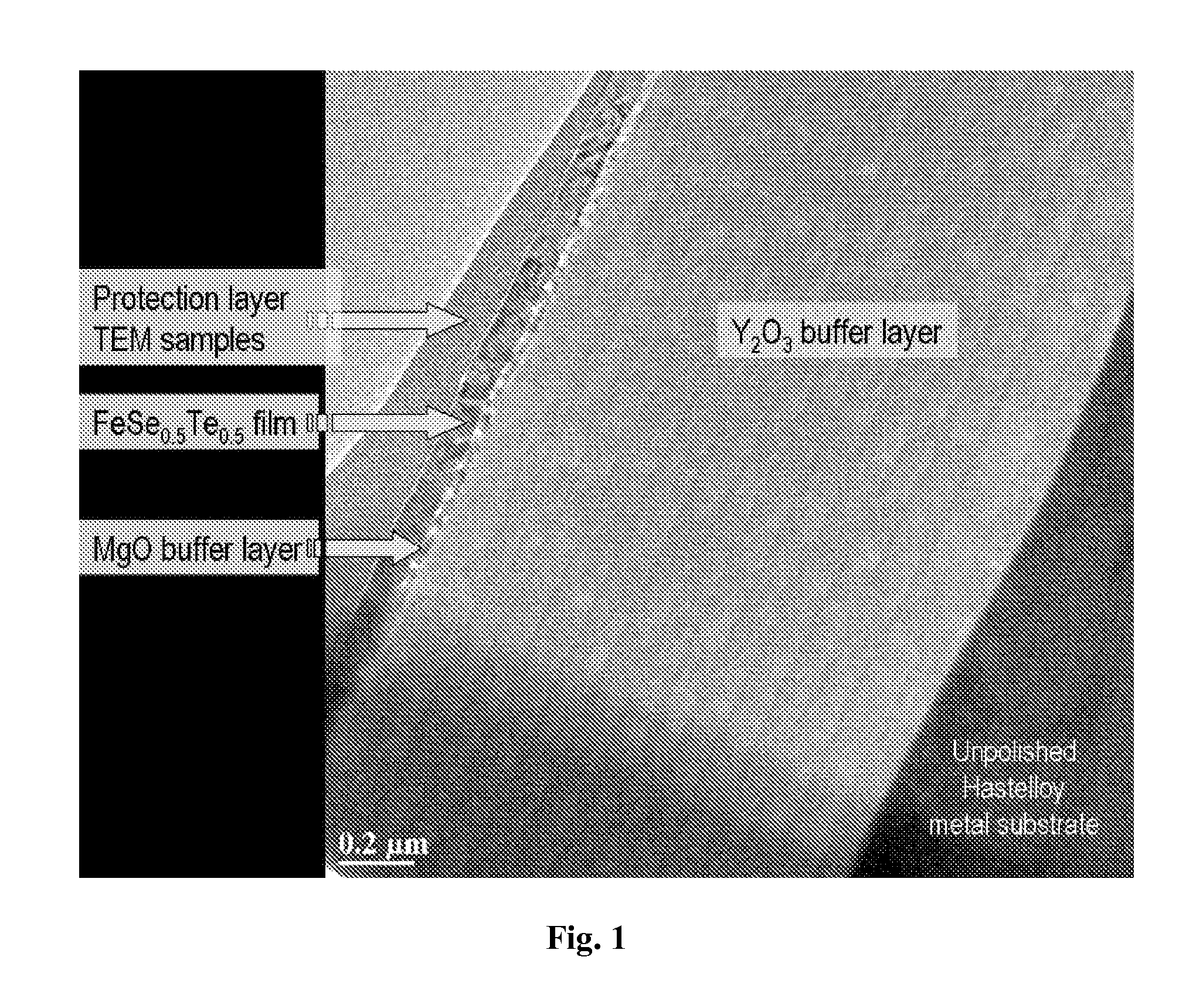Iron based superconducting structures and methods for making the same
a superconducting structure and iron-based technology, applied in the direction of superconducting magnets/coils, instruments, magnetic bodies, etc., can solve the problems of limited application, difficult manufacturing steps, and inability to make superconducting tapes or wires for large-scale applications
- Summary
- Abstract
- Description
- Claims
- Application Information
AI Technical Summary
Benefits of technology
Problems solved by technology
Method used
Image
Examples
example 1
[0050]The films depicted in FIGS. 1 and 2 have a composition of FeSe0.5Te0.5 and were grown by pulsed laser deposition (PLD). The films were deposited on single crystalline LaAlO3 (LAO) substrates and buffered metal templates using a KrF excimer laser (wavelength: 248 nm) with an energy density of ˜3.0 J / cm2 and a repetition rate of 5 Hz. The substrate temperature was varied from 350° C. to 450° C. The time to deposit the 400-nm film was about 30 minutes. Deposition and subsequent cooling were carried out under a vacuum of ˜10−6 torr. The heater was shut off after deposition to allow the structure to cool rapidly.
[0051]The templates were manufactured in two steps. First, an Y2O3 layer was made on unpolished Hastelloy® by sequential solution deposition to reduce the roughness of the tape surface, then a bi-axially textured MgO layer was deposited on top by the IBAD technique. (Matias, et al. J. Mater. Res. 24, 125 (2009); incorporated herein by reference in its entirety.) The very hi...
example 2
[0054]Resistivity was measured by the standard four-probe method in a physical property measurement system (Quantum Design, PPMS) and magnetization was measured in a superconducting quantum interference device (Quantum Design, MPMS).
[0055]FIG. 3 depicts the behavior of resistance with temperature and magnetic field in a thin film of FeSe0.5Te0.5 on a MgO-buffered nickel alloy substrate prepared by IBAD. The superconducting transition temperature is on par with that of bulk samples.
[0056]FIG. 4 depicts the behavior of resistance with temperature and magnetic field in a thin film of FeSe0.5Te0.5 on a CeO2-buffered nickel alloy substrate prepared by the RABiTS technique. The onset superconducting transition temperature is about the same as, if not higher than, that of similar films made on single crystal substrates.
[0057]FIG. 5 shows the behavior of critical current density with temperature and magnetic field of a thin film of FeSe0.5Te0.5 grown on a single-crystal substrate of LaAlO3 ...
example 3
[0058]The conformation of the crystal lattice of the FeSe0.5Te0.5 superconductors grown by PLD on the STO substrate was studied using X-ray diffraction spectroscopy. FIG. 7 illustrates the intensity spectrum from an XRD θ-2θ scan. Based on the XRD data, the in-plane lattice constant (a) of the superconductor was measured to be approximately 3.806Å, whereas the in-plane lattice constant of the STO substrate was measured to be approximately 3.905Å. The in-plane lattice constant of the fabricated superconductors was about the same with the bulk value, whereas the out-of-plane lattice constant (c) was always shorter.
PUM
| Property | Measurement | Unit |
|---|---|---|
| thickness | aaaaa | aaaaa |
| thickness | aaaaa | aaaaa |
| thickness | aaaaa | aaaaa |
Abstract
Description
Claims
Application Information
 Login to View More
Login to View More - R&D
- Intellectual Property
- Life Sciences
- Materials
- Tech Scout
- Unparalleled Data Quality
- Higher Quality Content
- 60% Fewer Hallucinations
Browse by: Latest US Patents, China's latest patents, Technical Efficacy Thesaurus, Application Domain, Technology Topic, Popular Technical Reports.
© 2025 PatSnap. All rights reserved.Legal|Privacy policy|Modern Slavery Act Transparency Statement|Sitemap|About US| Contact US: help@patsnap.com



